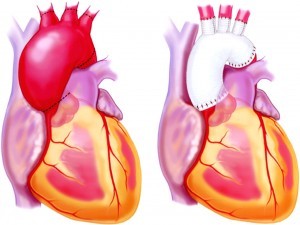A new case report describes the case of a 55 year old man who presented to the emergency room with a positional headache. He was diagnosed with Spontaneous Intracranial Hypotension (SIH) with bilateral subdural fluid collections. Spinal imaging failed to reveal the location of the leak. Symptoms resolved gradually without treatment.
A positive family history of ascending aortic aneurysm led physicians to order an echocardiogram, which was normal.
Seven months later, he developed chest pain, repeat echo revealed aortic root (45 mm) and ascending aortic dilatation (42 mm). Subsequent genetic testing revealed the specific marker, SMAD3. Together with clinical findings which included dural ectasia, spondylolisthesis, long slender fingers, pes planus and mild osteoarthritis, he was diagnosed with Aneurysms-Osteoarthritis Syndrome.
Other studies looking at heritable disorders of connective tissue in SIH patients have reported on a higher prevalence of aortic root dilatation, but this is the first reported case of this specific marker, SMAD3 in SIH.
A previous study (see second abstract below) looked specifically at echocardiographic findings in patients with spontaneous spinal CSF leaks and found that 20 percent had abnormalities including aortic root dilatation. The authors of this earlier study suggested echocardiographic screening of SIH patients who have even minor clinical findings suggestive of a heritable disorder of connective tissue.
Spontaneous Intracranial Hypotension as First Symptom of Aneurysms-Osteoarthritis Syndrome: A Case Report
Koppen H, Baars MJ, van Gils A, Vis JC.
Headache. 2015 May;55(5):711-2.
No abstract available
PMID: 25877775
Echocardiographic findings in patients with spontaneous CSF leak
Pimienta AL, Rimoin DL, Pariani M, Schievink WI, Reinstein E.
J Neurol. 2014 Oct;261(10):1957-60. doi: 10.1007/s00415-014-7438-0. Epub 2014 Jul 25.
Abstract
The presence of cardiovascular abnormalities in patients with spontaneous cerebrospinal fluid (CSF) leaks are not well-documented in the literature, as cardiovascular evaluation is not generally pursued if a patient does not exhibit additional clinical features suggesting an inherited connective tissue disorder. We aimed to assess this association, enrolling a consecutive group of 50 patients referred for spinal CSF leak consultation. Through echocardiographic evaluation and detailed medical history, we estimate that up to 20 % of patients presenting with a spontaneous CSF leak may have some type of cardiovascular abnormality. Further, the increase in prevalence of aortic dilatation in our cohort was statistically significant in comparison to the estimated population prevalence. This supports a clinical basis for echocardiographic screening of these individuals for cardiovascular manifestations that may have otherwise gone unnoticed or evolved into a more severe manifestation.
PMID: 25059392


